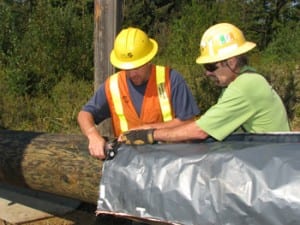
Seattle City Light is helping to preserve the environment thanks to a new method for protecting light poles against critter damage and rot.
For the past year, pole crews have been applying a protective sheet of layered plastic to the buried end of some new light poles. The plastic barrier keeps moisture away from the wood, extending the pole’s service life and preventing the leaching of wood preservatives.
The use of plastic barriers is not new at City Light. One decade ago, Seattle City Light became the first utility to protect the buried end of light poles with a barrier system. But until a year ago, the barrier was applied to the poles at the factory. The barriers were often damaged during shipping, handling, and storage, and many were not waterproof by the time they reached the site.
at City Light. One decade ago, Seattle City Light became the first utility to protect the buried end of light poles with a barrier system. But until a year ago, the barrier was applied to the poles at the factory. The barriers were often damaged during shipping, handling, and storage, and many were not waterproof by the time they reached the site.
“We were not getting our money’s worth,” said Steve Crume, SCL joint use manager and former pole engineer.
The new barrier looks like a sleeve and can be installed quickly in the field, just before the pole goes in the ground. It is much cheaper, costing about $40 per pole, compared with $140 for a barrier installed at the mill. The savings add up quickly – City Light installs about 1,200 poles in a year.
The new barriers are produced by Copper Care in Colorado. The barrier consists of heavy duty plastic films, with a layer of copper foil in the middle.
Though cost was important, the main reasons for using the barriers are to protect the environment and extend the life cycle of critical infrastructure. City Light uses copper napthenate to treat wood against rot and insect damage. Though this chemical is much safer than other treatments, it can still leach into the soil and affect nearby vegetation and marine life. The plastic barrier prevents this from happening. In field tests, vegetation will often grow right up to the base of the poles with barriers.
“The barrier lets you use less chemicals, and the pole lasts longer,” said Brad Combs, an SCL strategic advisor. Brad is a former pole engineer and a member of the American Wood Protection Association, which sets standards for pole treatment.